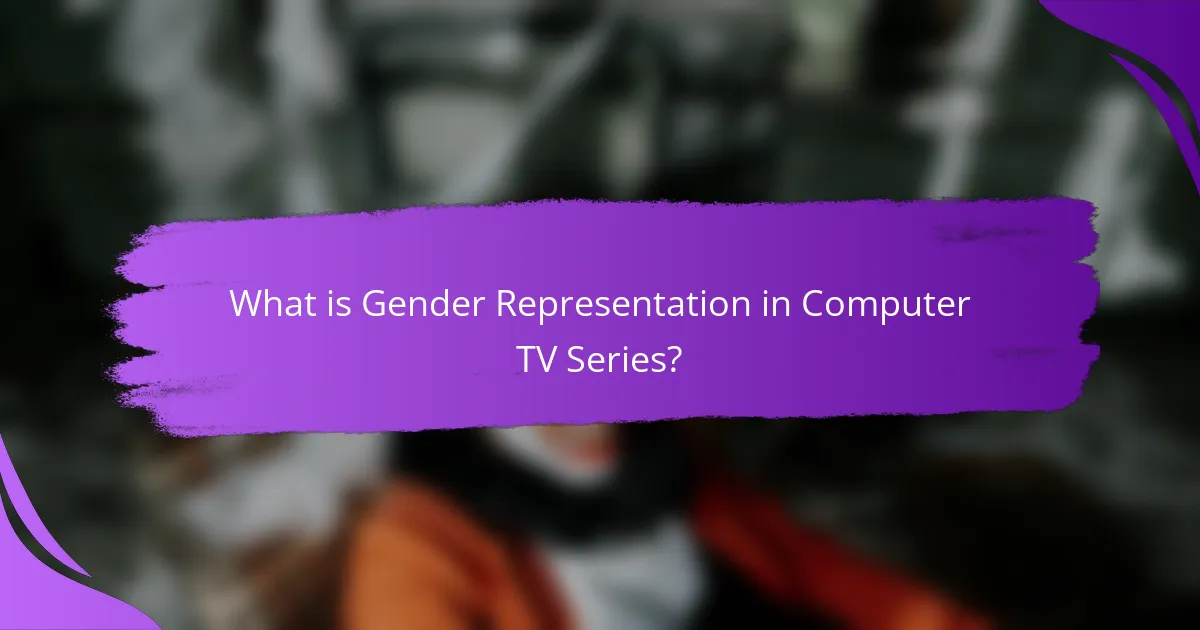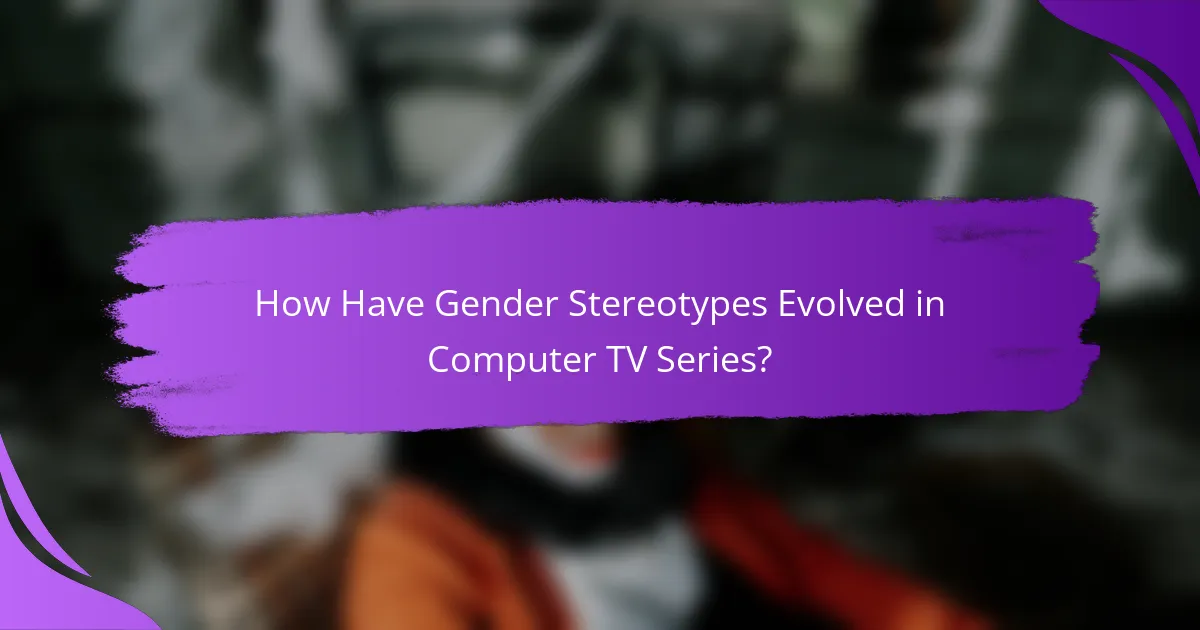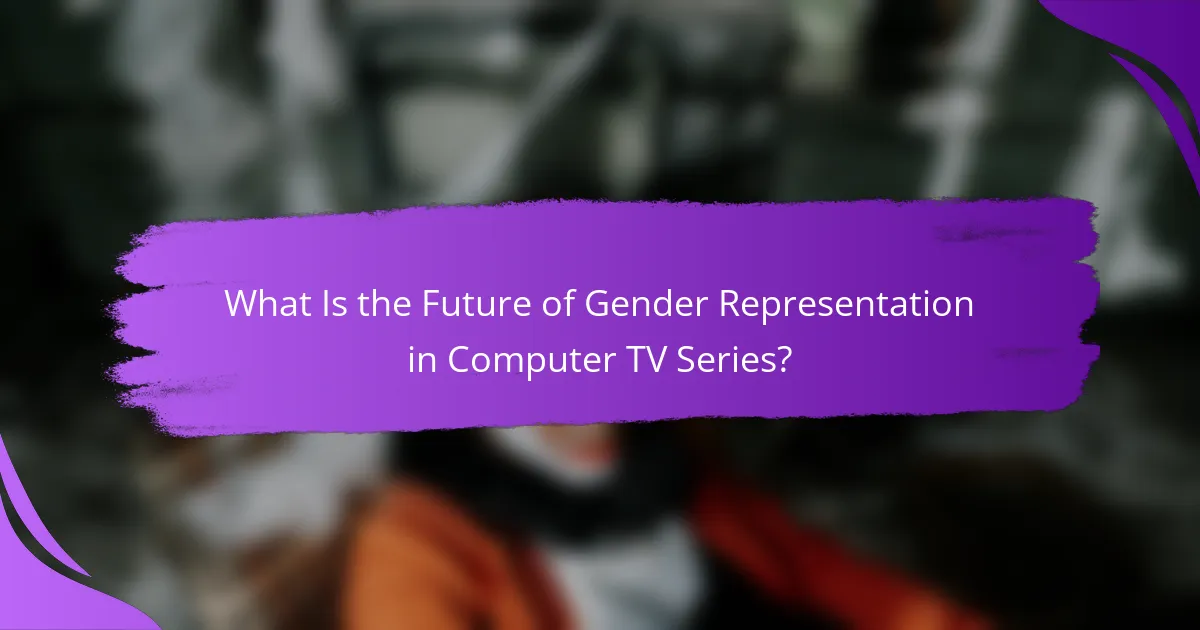Gender representation in computer TV series encompasses the portrayal of different genders, character roles, and the presence of stereotypes within these shows. Historically, male characters have dominated as protagonists, while female characters have often been relegated to supporting roles. Recent trends indicate a shift towards more balanced representation, with series like “Silicon Valley” and “Halt and Catch Fire” featuring strong female leads that challenge traditional stereotypes. This evolution reflects broader societal changes regarding gender equality and highlights the increasing recognition of diverse gender identities in the media landscape. Research shows that improved representation positively influences audience perceptions, indicating a promising future for gender diversity in computer TV series.

What is Gender Representation in Computer TV Series?
Gender representation in computer TV series refers to how different genders are portrayed in these shows. This includes the roles assigned to characters, the stereotypes they embody, and the overall balance of gender representation. Many computer TV series have historically depicted male characters as the primary protagonists. Female characters often face stereotypical roles, such as being assistants or love interests.
Recent studies indicate a shift towards more balanced gender representation. For example, shows like “Silicon Valley” and “Halt and Catch Fire” have introduced strong female leads. This change reflects broader societal discussions on gender equality. According to a 2020 report by the Geena Davis Institute on Gender in Media, only 34% of speaking characters in family films were female.
This statistic highlights the ongoing need for improvement in gender representation across media, including computer TV series. The portrayal of diverse gender identities is also gaining attention, contributing to a more inclusive narrative landscape.
Why is Gender Representation Important in Media?
Gender representation is important in media because it shapes societal perceptions and influences cultural norms. Diverse representation allows audiences to see varied experiences and identities. It can challenge stereotypes and promote understanding. Studies show that gender-balanced media can lead to more equitable attitudes in society. For instance, a report by the Geena Davis Institute on Gender in Media indicates that films with strong female characters perform better at the box office. Furthermore, gender representation affects the aspirations of young viewers. Research by Common Sense Media found that girls exposed to diverse female roles are more likely to pursue STEM careers. Thus, gender representation in media not only reflects reality but also actively shapes it.
How does Gender Representation Affect Audience Perception?
Gender representation significantly affects audience perception by shaping their understanding of gender roles. When a series portrays diverse and realistic gender representations, it can challenge stereotypes. This leads to broader acceptance of various identities and experiences. Conversely, limited or negative portrayals reinforce harmful stereotypes. Research shows that media representation influences societal norms and individual beliefs. A study by Smith et al. (2019) found that positive gender representation in media correlates with increased empathy and understanding among viewers. Thus, effective gender representation can enhance audience perception and foster inclusivity.
What Historical Context Influences Gender Representation in TV?
Historical context significantly influences gender representation in TV. Early television often reflected traditional gender roles, portraying women primarily as homemakers. The mid-20th century saw a shift as women entered the workforce, leading to more diverse character roles. The feminist movements of the 1960s and 1970s further challenged stereotypes, promoting stronger female characters. In the 1980s and 1990s, shows like “Murphy Brown” and “The X-Files” featured women in professional roles. Recent decades have seen increased representation of [censured] characters and complex female narratives. Research indicates that these historical shifts have shaped audience expectations and industry standards.
What Are the Common Character Roles in Computer TV Series?
Common character roles in computer TV series include the hacker, the programmer, and the tech entrepreneur. The hacker often serves as a rebellious figure, using skills to navigate the digital world. The programmer typically embodies the analytical mindset, solving complex problems through coding. The tech entrepreneur often represents ambition, driving innovation and business growth in technology. These roles reflect stereotypes prevalent in the tech industry. For instance, hackers are frequently depicted as anti-heroes, while programmers are shown as socially awkward. These portrayals influence audience perceptions of gender roles within the tech field.
How Do Male and Female Characters Differ in Roles?
Male and female characters often differ significantly in their roles within computer TV series. Male characters typically occupy positions of power and authority. They are frequently portrayed as heroes, leaders, or action-oriented figures. Female characters, in contrast, are often cast in supportive or secondary roles. They may be depicted as caregivers, romantic interests, or emotional anchors.
Research shows that male characters are more likely to be involved in plot-driving actions. In contrast, female characters often serve to enhance the male protagonist’s storyline. For example, a study by the Geena Davis Institute on Gender in Media found that male characters outnumber female characters by a ratio of 2:1 in family films. This disparity highlights the prevalence of traditional gender roles.
Moreover, male characters are often given more dialogue and agency. Female characters may experience limited development and depth compared to their male counterparts. This trend reflects broader societal stereotypes about gender roles. Overall, the differences in character roles contribute to the ongoing discourse on gender representation in media.
What Are the Stereotypes Associated with Gender Roles?
Stereotypes associated with gender roles include the belief that men are dominant and assertive while women are nurturing and submissive. These stereotypes often dictate behaviors, expectations, and career choices. For example, men are frequently viewed as natural leaders, while women are often seen as caregivers. In media portrayals, men are typically shown in positions of power. Conversely, women are often depicted in supportive or secondary roles. Research shows that these stereotypes can influence self-perception and career aspirations. A study by Eagly and Karau (2002) highlights how gender stereotypes affect leadership perceptions. These stereotypes can limit opportunities and reinforce traditional gender dynamics.

How Have Gender Stereotypes Evolved in Computer TV Series?
Gender stereotypes in computer TV series have evolved significantly over the years. Early series often portrayed women in subordinate or overly sexualized roles. Characters like Penny from “The Big Bang Theory” exemplified this trend, often being sidelined in technical discussions.
As the genre progressed, more complex female characters emerged. For instance, characters like Felicity Smoak in “Arrow” showcased women as skilled hackers and tech experts. This shift reflects a broader societal change towards recognizing women’s capabilities in STEM fields.
Recent series, such as “Silicon Valley” and “The IT Crowd,” have introduced female leads who challenge traditional stereotypes. These characters often possess both technical skills and leadership qualities. The portrayal of gender roles in these shows illustrates a growing acceptance of women as equals in the tech industry.
Research indicates that diverse representation positively impacts audience perceptions. A study by the Geena Davis Institute on Gender in Media found that female characters in tech roles are increasing, contributing to a more balanced portrayal in media. This evolution reflects ongoing changes in societal attitudes toward gender equality in technology.
What Are Some Notable Examples of Gender Stereotypes in TV?
Notable examples of gender stereotypes in TV include the portrayal of women as overly emotional and men as stoic. In many series, female characters are often depicted in nurturing roles, such as mothers or caretakers. Conversely, male characters frequently embody traits like aggression and dominance. Shows like “Friends” illustrate these stereotypes, with characters like Ross often taking on the assertive male role, while Rachel is shown as the emotional support. Additionally, in “The Big Bang Theory,” female characters are often relegated to romantic interests rather than being portrayed as scientists or intellectual equals. These patterns reinforce traditional gender roles and limit character development.
How Do These Stereotypes Manifest in Character Development?
Stereotypes manifest in character development through predictable traits and behaviors assigned to characters based on gender. Female characters often display nurturing qualities, while male characters may exhibit aggression or leadership. These traits shape their roles in the narrative, often limiting their complexity. For example, female characters might be relegated to supportive roles, while male characters drive the plot. Research shows that these stereotypes can reinforce societal norms and expectations. A study by Smith et al. (2019) highlights that female characters are often portrayed in less dominant roles in media. This consistent pattern affects audience perceptions and expectations of gender roles in real life.
What Impact Do Stereotypes Have on Viewer Expectations?
Stereotypes significantly shape viewer expectations in media. They create preconceived notions about characters based on gender, race, and other traits. For example, female characters are often portrayed in nurturing roles, leading viewers to expect such behaviors. This can limit the perception of women’s capabilities in diverse roles. Studies show that audiences may judge a show’s quality based on how well it adheres to these stereotypes. Research indicates that when characters break stereotypes, it can lead to increased viewer engagement and satisfaction. This highlights the power of representation in shaping audience perceptions and expectations.
How Do Recent Shows Challenge Traditional Gender Roles?
Recent shows challenge traditional gender roles by portraying diverse characters in non-stereotypical roles. These characters often defy conventional expectations associated with their genders. For example, female characters frequently take on leadership positions and exhibit traits traditionally attributed to masculinity. Simultaneously, male characters are depicted as vulnerable and emotionally expressive.
Shows like “The Good Place” and “Orange is the New Black” exemplify this shift. In “The Good Place,” Eleanor Shellstrop embodies assertiveness while also exploring her emotional depth. “Orange is the New Black” features a range of female characters with complex, multifaceted identities, breaking the mold of typical portrayals.
This trend reflects societal changes regarding gender perception. According to a study by the Geena Davis Institute on Gender in Media, female representation in media has improved, with an increase in strong female leads. These portrayals resonate with audiences, fostering a broader acceptance of varied gender expressions.
What Innovations in Character Design Promote Gender Equality?
Innovations in character design that promote gender equality include diverse representation, non-stereotypical roles, and inclusive storytelling. Diverse representation allows for characters of various backgrounds and identities, challenging traditional gender norms. Non-stereotypical roles enable characters to break free from conventional gender expectations. Inclusive storytelling integrates female perspectives, enriching narratives and fostering empathy. Research shows that shows with gender-diverse characters attract broader audiences and enhance viewer engagement. For instance, a study by the Geena Davis Institute on Gender in Media found that gender-balanced films perform better at the box office. These innovations collectively contribute to a more equitable portrayal of genders in media.
How Are Female Characters Portrayed as Leaders and Innovators?
Female characters are portrayed as leaders and innovators in various computer TV series through their strong decision-making skills and creative problem-solving abilities. These characters often hold significant positions, such as executives or scientists, showcasing their capability to lead teams effectively. For example, characters like Dr. Amy Farrah Fowler in “The Big Bang Theory” demonstrate expertise in her field while contributing innovative ideas.
Moreover, female characters frequently challenge traditional gender roles, displaying assertiveness and intelligence in high-pressure situations. In “Westworld,” Dolores Abernathy evolves from a victim to a revolutionary leader, emphasizing empowerment and resilience.
Statistics indicate that shows with prominent female leaders receive higher viewer ratings, reflecting audience appreciation for diverse representation. This portrayal not only inspires viewers but also promotes discussions about gender equality in leadership roles.

What Is the Future of Gender Representation in Computer TV Series?
The future of gender representation in computer TV series is expected to become more balanced and diverse. Increasing awareness of gender stereotypes is driving this change. Many creators are now prioritizing authentic portrayals of women and non-binary characters. Research indicates that shows with diverse casts achieve higher viewer engagement. For example, a study by the Geena Davis Institute on Gender in Media found that films with female leads perform better at the box office. Additionally, streaming platforms are investing in content that features strong female protagonists. This trend reflects a broader societal push for equality and representation. As a result, audiences can anticipate more nuanced characters and storylines in future computer TV series.
How Can Writers and Producers Improve Gender Representation?
Writers and producers can improve gender representation by creating diverse characters with depth. This includes avoiding stereotypes and showcasing women in varied roles. They should include women in the writing and production process to provide authentic perspectives. Research indicates that shows with female writers have 50% more female characters. Additionally, they can ensure that storylines reflect real-life gender dynamics. This approach not only enhances representation but also resonates with broader audiences.
What Role Does Audience Feedback Play in Shaping Representation?
Audience feedback significantly influences representation in media. It shapes character roles and narratives based on viewer preferences and concerns. Producers and writers often analyze audience reactions to adjust storylines. For example, social media platforms allow instant feedback on character portrayals. This feedback can lead to more diverse and authentic representations. Studies show that when audiences demand change, creators often respond. A notable case is the shift in female character roles in popular series due to viewer advocacy. This interaction between audience feedback and representation fosters a more inclusive media landscape.
What Best Practices Should Be Followed for Inclusive Storytelling?
Best practices for inclusive storytelling include diverse character representation, authentic narratives, and audience engagement. Diverse character representation ensures that various identities and experiences are reflected in the story. Authentic narratives involve researching and accurately portraying cultures and communities. Engaging with the audience through feedback can enhance relatability and understanding. Additionally, collaborating with individuals from underrepresented groups can provide valuable insights. According to a study by the Geena Davis Institute on Gender in Media, films with diverse casts perform better at the box office. This highlights the importance of inclusivity in storytelling.
What Resources Are Available for Understanding Gender Representation in Media?
Resources for understanding gender representation in media include academic journals, books, and online databases. Key academic journals such as “Feminist Media Studies” and “Journal of Gender Studies” publish research on this topic. Books like “Gender and Media: Representing, Producing, and Consuming Gender” provide in-depth analyses. Online databases like JSTOR and Google Scholar offer access to a wealth of peer-reviewed articles. Organizations such as the Geena Davis Institute on Gender in Media provide valuable research and statistics. Reports from these organizations highlight trends in gender representation. For example, the Geena Davis Institute’s report found that female characters are underrepresented in film and television. These resources collectively contribute to a comprehensive understanding of gender representation in media.
Gender representation in computer TV series examines how different genders are portrayed, focusing on character roles, stereotypes, and the evolution of representation. Historically, male characters dominated as protagonists, while female characters often occupied secondary roles. Recent trends indicate a shift towards more balanced representation, with strong female leads emerging in shows like “Silicon Valley” and “Halt and Catch Fire.” The article discusses the significance of gender representation in shaping societal perceptions, the impact of stereotypes on audience expectations, and how recent shows challenge traditional gender roles, ultimately highlighting the importance of inclusive storytelling and the future of gender representation in media.